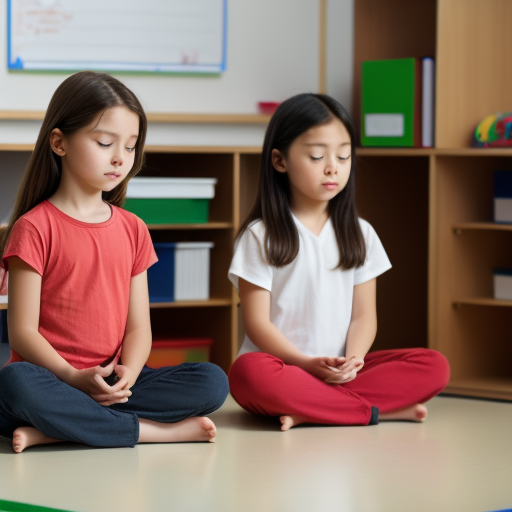This post contains: 11 Lessons and 12 Activities you can try with your children right away.
Lesson 1: Discover the Power of Your Breath
Description: Understand the significance of conscious breathing and its impact on emotional well-being. Explore how the breath connects the mind and body, and its role in promoting relaxation and focus.
Summary: This lesson introduces learners to the fundamental concept of conscious breathing and its potential to enhance emotional regulation and overall well-being.
Instructions: Begin by asking learners to sit comfortably and close their eyes. Guide them through a short-guided breath awareness exercise, encouraging them to notice the natural rhythm of their breath without trying to control it. Afterward, facilitate a group discussion to share experiences and insights.

Lesson 2: Nasal Breathing Technique
Description: Teach learners the benefits of breathing in and out through the nose and its calming effect on the nervous system. Explain how nasal breathing optimizes oxygen intake and promotes relaxation.
Summary: This lesson emphasizes the importance of nasal breathing and its potential to bring a sense of calm and focus to daily life.
Instructions: Lead learners through a step-by-step nasal breathing exercise. Instruct them to inhale slowly and deeply through the nose, feeling the cool air entering their nostrils, and exhale gently, noticing the warm air leaving the nose. Encourage participants to practice nasal breathing during the day and share their experiences in the next session.

Lesson 3: Diaphragmatic Breathing Practice
Description: Introduce diaphragmatic breathing and its role in stimulating the vagus nerve to induce relaxation. Explain how diaphragmatic breathing helps release tension and calm the mind.
Summary: This lesson teaches learners a simple yet effective technique for relaxing the body and mind through diaphragmatic breathing.
Instructions: Guide participants in a diaphragmatic breathing exercise. Instruct them to place one hand on their chest and the other on their abdomen. Encourage them to take a deep breath, feeling their abdomen expand, and then exhale slowly, allowing the abdomen to relax. Repeat the exercise several times, focusing on the sensation of the breath.

Huia Maree Hikaiti
Lesson 4: Balloon Breath for Kids
Description: Explore a child-friendly conscious breathing technique using the “Balloon Breath.” This fun activity helps children engage in conscious breathing through playful visualization.
Summary: This lesson equips educators with a creative method to teach conscious breathing to young children in an enjoyable and age-appropriate way.
Instructions: Show a visual representation of a balloon and explain to children that they are going to fill their “balloon” (abdomen) with air like a real balloon. Instruct them to take a deep breath through the nose and inflate their “balloon” as they fill their abdomen with air. Then, guide them to slowly release the air through their nose, imagining their “balloon” deflating. Repeat the activity several times, encouraging children to use their imaginations.
Lesson 5: Butterfly Breath
Description: Introduce the “Butterfly Breath” technique, which combines conscious breathing with gentle movements, fostering mindfulness and relaxation in children.
Summary: This lesson provides educators with an interactive activity that promotes mindfulness and body awareness in young children.
Instructions: Instruct children to sit comfortably on the floor with their legs crossed. Demonstrate the butterfly breath by placing their hands on their chest and belly. Inhale slowly through the nose as they bring their hands together in front of their chest, and then exhale slowly, opening their hands apart like butterfly wings. Repeat the motion while coordinating their breath. Encourage children to focus on their breath and the movement of their hands.
Lesson 6: Bubble Breath Play
Description: Engage children in a playful conscious breathing activity using bubbles. This activity encourages children to practice deep and focused breathing.
Summary: This lesson introduces a light hearted approach to conscious breathing, appealing to young children’s playful nature.
Instructions: Provide each child with a small bottle of bubble solution and a bubble wand. Instruct them to take a deep breath and blow through the wand to create bubbles. Encourage them to continue blowing bubbles while practicing slow and deep breaths.
Lesson 7: Weather Breath Visualization
Description: Teach children to connect their breath with different weather elements, such as a gentle breeze or a strong gust of wind. This visualization exercise helps children understand the variability of their breath.
Summary: This lesson offers a creative and imaginative way for children to explore their breath and its ever-changing nature.
Instructions: Ask children to sit comfortably and close their eyes. Describe different weather conditions, such as a calm breeze or a powerful storm, and instruct them to match their breath to each weather element. For example, during a calm breeze, they can take slow and gentle breaths, and during a powerful storm, they can take deep and forceful breaths.
Lesson 8: Four-Count Breathing
Description: Introduce children to a simple and effective conscious breathing technique called “Four-Count Breathing.” This technique encourages children to count their breaths, promoting focus and calmness.
Summary: This lesson provides a structured breathing exercise for children to practice mindfulness and develop breath awareness.
Instructions: Guide children to inhale slowly for a count of four, hold their breath for a count of four, exhale for a count of four, and then hold their breath again for a count of four. Repeat the process several times, encouraging children to maintain a steady and rhythmic breath.
Lesson 9: Breathing with Nature
Description: Connect children with nature through conscious breathing. This activity encourages children to breathe in harmony with the sounds and rhythms of nature.
Summary: This lesson fosters a sense of interconnectedness between children and the natural world through mindful breathing.
Instructions: Take children outside, either to a garden or a natural setting. Instruct them to sit or stand quietly and listen to the sounds of nature, such as the rustling of leaves or the chirping of birds. Encourage children to synchronize their breath with the natural sounds, breathing in as they hear a sound and breathing out as the sound fades away.
Lesson 10: Calm Ocean Breath
Description: Introduce the “Calm Ocean Breath,” a breathing exercise that helps children visualize the ebb and flow of ocean waves while promoting relaxation.
Summary: This lesson offers a soothing activity that allows children to connect with the calming imagery of the ocean through conscious breathing.
Instructions: Instruct children to sit comfortably and imagine they are at the beach, watching the gentle waves come and go. Guide them to inhale deeply through their nose, visualizing the waves rising, and then exhale slowly, imagining the waves receding. Encourage children to continue the calming breath as they connect with the ocean imagery.
Lesson 11: Breathing Through Imaginary Straws
Description: Teach children the concept of mindful breathing by pretending to drink through imaginary straws, incorporating conscious breaths in the process.
Summary: This lesson introduces children to a playful activity that reinforces the importance of nasal breathing.
Instructions: Ask children to sit in a circle and pretend they have a long, colourful straw in their hand. Instruct them to take a deep breath through their nose, and as they exhale, pretend to blow bubbles through the straw. Encourage children to make their imaginary
Activity 12: Breathing Buddies
Description: Introduce “Breathing Buddies” to the children. These can be small stuffed animals or soft toys. Each child can choose their own “Breathing Buddy” to practice conscious breathing with.
Summary: The “Breathing Buddies” activity helps children associate conscious breathing with a comforting and calming presence. It creates a sense of connection and security during breathing exercises.
Instructions:
- Gather the “Breathing Buddies” and sit in a circle with the children.
- Explain that the Buddies will be our special friends during breathing time.
- Guide the children to hold their Buddies on their laps.
- Instruct them to take slow, deep breaths, matching the rise and fall of their Buddies’ chests.
- Encourage them to focus on their Buddies’ breaths and make their own breaths match the rhythm.
- Take a few minutes to practice together and then allow the children to breathe with their Buddies independently.
Teaching Guide: Emphasize the importance of using the “Breathing Buddies” as a tool for self-regulation and emotional comfort. Encourage the children to name their Buddies and form a positive connection with them during mindful breathing exercises.
Activity 13: Rainbow Breaths
Description: Introduce “Rainbow Breaths” as a colourful and fun breathing exercise that promotes breath awareness and creativity.
Summary: The “Rainbow Breaths” activity encourages children to visualize the colours of the rainbow while taking deep breaths, enhancing their imagination and breath control.
Instructions:
- Sit or stand comfortably with the children.
- Instruct them to take a deep breath in through their noses and imagine the colour red filling their bodies.
- As they exhale, ask them to imagine the colour red leaving their bodies.
- Repeat the process for orange, yellow, green, blue, indigo, and violet, creating a rainbow of breaths.
- Encourage the children to move their arms in an arc-like motion as they breathe in each colour.
- Continue the “Rainbow Breaths” exercise for several rounds, gradually slowing the breaths down.
Teaching Guide: Emphasize the creative aspect of “Rainbow Breaths” and how it can be used as a tool for calming down and focusing. Encourage the children to express their feelings and experiences with colours during the exercise.
Activity 14: Breathing with Props
Description: Introduce props such as bubbles, feathers, or pinwheels to make conscious breathing more engaging and interactive.
Summary: Using props during breathing exercises adds a playful element to conscious breathing and keeps the children interested and motivated.
Instructions:
- Provide each child with a prop, such as a bubble wand, a feather, or a pinwheel.
- Guide them to take slow, deep breaths while interacting with the prop.
- For example, they can blow bubbles and take deep breaths in between, or they can blow on the pinwheel to see it spin while practicing conscious breathing.
- Encourage them to explore different ways of using the props while maintaining breath awareness.
- After the activity, discuss how the props made the breathing exercise more enjoyable and relaxing.
Teaching Guide: Highlight the benefits of using props to engage children in conscious breathing. Emphasize that conscious breathing can be a fun and enjoyable experience with the right tools.
Activity 15: Nature’s Breath
Description: Take the children outdoors to practice conscious breathing in nature.
Summary: Nature’s Breath allows children to connect with the natural world and find peace and calm through conscious breathing in an outdoor setting.
Instructions:
- Lead the children to a quiet and peaceful outdoor area, such as a garden or a park.
- Encourage them to find a comfortable spot to sit or lie down.
- Instruct them to take slow, deep breaths and pay attention to the sounds and sensations of nature around them.
- Guide them to visualize their breaths merging with the natural elements, like the rustling of leaves or the chirping of birds.
- Take a few minutes for the children to practice conscious breathing in nature’s embrace.
- After the activity, gather the children to share their experiences and reflections on the exercise.
Teaching Guide: Emphasize the importance of connecting with nature as a way to enhance the benefits of conscious breathing. Encourage the children to find moments of peace and mindfulness in nature whenever possible.
Activity 16: Breathing Beads Bracelet
Description: Create “Breathing Beads Bracelets” as a tactile reminder for children to practice conscious breathing throughout the day.
Summary: The “Breathing Beads Bracelet” activity provides a wearable tool that children can use as a visual and tactile cue to practice conscious breathing anytime, anywhere.
Instructions:
- Provide each child with a piece of elastic string and a set of coloured beads.
- Explain that each bead represents one deep breath.
- Guide the children to string the beads onto the elastic, counting and taking a deep breath for each bead they add.
- Once the bracelets are complete, invite the children to wear them and use them as a reminder to take conscious breaths throughout the day.
Teaching Guide: Emphasize the portability of the “Breathing Beads Bracelet” and encourage children to use it whenever they need a moment of calm and focus.
Activity 17: Breathing Bubble Art
Description: Combine conscious breathing with creative expression through “Breathing Bubble Art.”
Summary: “Breathing Bubble Art” allows children to create colourful artwork while practicing conscious breathing, promoting relaxation and self-expression.
Instructions:
- Provide each child with a small container of bubble solution and a bubble wand.
- Guide them to take slow, deep breaths as they blow bubbles onto a piece of paper or canvas.
- Encourage the children to observe the patterns and shapes created by the bubbles as they land on the surface.
- After the activity, have a group discussion about how the act of blowing bubbles and conscious breathing made them feel.
Teaching Guide: Highlight the therapeutic and expressive aspects of “Breathing Bubble Art.” Discuss how creative activities can enhance the benefits of conscious breathing.
Activity 18: Breathing Story time
Description: Integrate conscious breathing into story time by incorporating mindful breathing pauses during reading.
Summary: “Breathing Story time” helps children relax and focus while engaging with a story, enhancing their listening skills and breath awareness.
Instructions:
- Select a storybook suitable for the children’s age group.
- As you read the story, periodically pause and guide the children to take a few deep breaths together before continuing with the reading.
- Use the pauses to discuss the emotions and themes in the story and how conscious breathing can help them manage their feelings.
Teaching Guide: Explain the benefits of incorporating conscious breathing into everyday activities like story time. Encourage educators to continue using “Breathing Story time” as a regular practice in their classrooms.
Activity 19: Breathing Puzzles
Description: Create “Breathing Puzzles” that encourage children to match breathing techniques with corresponding visuals.
Summary: “Breathing Puzzles” provide a playful way for children to learn different breathing techniques and match them with specific scenarios.
Instructions:
- Prepare a set of puzzle cards, each depicting a breathing technique (e.g., deep belly breathing, rainbow breaths, balloon breaths).
- On a separate set of cards, illustrate different scenarios or emotions (e.g., feeling anxious, feeling happy, feeling sleepy).
- Guide the children to match the breathing techniques with the appropriate scenarios, discussing how each technique can help in different situations.
Teaching Guide: Emphasize the versatility of “Breathing Puzzles” in teaching children to apply conscious breathing to various emotional states and situations.
Activity 20: Breathing Reflection Journals
Description: Introduce “Breathing Reflection Journals” for children to record their experiences and observations during conscious breathing exercises.
Summary: “Breathing Reflection Journals” provide an opportunity for children to reflect on their breathing practices and their emotional well-being.
Instructions:
- Provide each child with a simple journal or notebook.
- Encourage them to write or draw about their experiences with conscious breathing activities.
- Prompt the children with questions like, “How did conscious breathing make you feel?” or “When do you find conscious breathing most helpful?”
- Allow the children to share their journal entries with the group if they feel comfortable.
Teaching Guide: Stress the importance of self-reflection and how “Breathing Reflection ” can foster mindfulness and emotional awareness in children. Encourage educators to provide supportive feedback on the children’s journal entries.
Activity 21: Breathing Buddy
Description: Introduce a “Breathing Buddy” as a soft, stuffed toy that children can use during conscious breathing exercises.
Summary: The “Breathing Buddy” activity helps children feel comforted and supported while practicing conscious breathing.
Instructions:
- Provide each child with a soft stuffed toy (Breathing Buddy).
- Guide the children to lie down on their backs with the Breathing Buddy resting on their belly.
- Instruct them to take slow, deep breaths, watching the Breathing Buddy rise and fall with their breaths.
- Encourage the children to name their Breathing Buddy and use it whenever they need a moment of relaxation.
Teaching Guide: Explain how the “Breathing Buddy” can serve as a calming and comforting tool during conscious breathing exercises.
Activity 22: Breathing Nature Walk
Description: Take children on a nature walk to practice conscious breathing while observing the natural environment.
Summary: The “Breathing Nature Walk” activity combines mindful breathing with nature exploration, promoting a sense of wonder and connection.
Instructions:
- Lead the children on a slow walk-in a nearby natural setting (e.g., a park or garden).
- Encourage them to take deep breaths as they observe the sights, sounds, and scents of nature.
- Pause occasionally to invite the children to share what they notice and how conscious breathing enhances their experience.
Teaching Guide: Emphasize the therapeutic of being in nature and how mindful breathing can deepen the connection with the environment.
Activity 23: Breathing Sound Exploration
Description: Use different sounds and music to guide children in practicing conscious breathing.
Summary: “Breathing Sound Exploration” introduces children to various auditory cues that facilitate focused breathing.
Instructions:
- Play calming instrumental music or nature sounds.
- Instruct the children to listen to the sounds and synchronize their breath with the rhythm of the music.
- Guide them to explore different breathing patterns as they listen to different sounds.
Teaching Guide: Explain the role of auditory cues in promoting relaxation and how “Breathing Sound Exploration” can be integrated into daily routines.
Activity 24: Breathing Mindfulness Jar
Description: Create a “Breathing Mindfulness Jar” as a visual aid for teaching deep breathing techniques.
Summary: The “Breathing Mindfulness Jar” provides a captivating visual representation of conscious breathing.
Instructions:
- Fill a clear jar with water and add a few drops of food colouring.
- Seal the jar and shake it gently to disperse the colour.
- Instruct the children to watch the swirling colours settle as they take slow breaths.
- Discuss how the process of breathing and the swirling colours are connected.
Teaching Guide: Highlight the calming effect of visual aids like the “Breathing Mindfulness Jar” in guiding children through conscious breathing exercises.
Activity 25: Breathing Body Scan
Description: Guide children in a “Breathing Body Scan” to promote relaxation and self-awareness.
Summary: The “Breathing Body Scan” activity helps children identify areas of tension and release stress through conscious breathing.
Instructions:
- Have the children sit or lie down in a comfortable position.
- Guide them to take deep breaths while mentally scanning their bodies from head to toe.
- Encourage them to notice any areas of tension or discomfort and use conscious breathing to release the tension.
Teaching Guide: Emphasize the mind-body connection and the benefits of using the “Breathing Body Scan” as a tool for self-regulation and relaxation.
Activity 26: Breathing Bubble Fun
Description: Incorporate bubbles into a breathing activity to engage children and make conscious breathing playful.
Summary: “Breathing Bubble Fun” encourages deep breathing through a fun and interactive bubble-blowing session.
Instructions:
- Provide each child with a bubble wand and a bottle of bubble solution.
- Instruct them to take a deep breath in through the nose and then blow the biggest bubble they can.
- Encourage the children to focus on their breathing and notice how it affects the size and shape of the bubbles.
Teaching Guide: Explain how this activity helps children practice conscious breathing while enjoying a playful sensory experience.
Activity 27: Breathing with Animals
Description: Use animal-themed prompts to guide children in mindful breathing exercises.
Summary: “Breathing with Animals” encourages children to imitate the breathing patterns of different animals.
Instructions:
- Choose a few animals (e.g., snake, rabbit, turtle) and show pictures or toys representing these animals.
- Describe how each animal breathes (e.g., slow and deep for a turtle, quick and shallow for a rabbit).
- Guide the children to imitate the breathing patterns of each animal as they make corresponding movements.
Teaching Guide: Emphasize the connection between conscious breathing and the natural world, promoting a sense of harmony and connection.
Activity 28: Breathing Visualizations
Description: Engage children’s imaginations with guided visualizations that involve conscious breathing.
Summary: “Breathing Visualizations” leads children through imaginary journeys while incorporating mindful breathing.
Instructions:
- Create a calming and imaginative scenario (e.g., flying in the clouds, swimming with dolphins).
- Instruct the children to close their eyes, take deep breaths, and imagine themselves in the chosen scenario.
- Guide them to use their breath to navigate and experience the visualization.
Teaching Guide: Explain how “Breathing Visualizations” can foster creativity, relaxation, and emotional well-being in children.
Activity 29: Breathing Sensory Bottles
Description: Make sensory bottles that provide visual and auditory cues for conscious breathing.
Summary: “Breathing Sensory Bottles” offer a calming and engaging tool for practicing conscious breathing.
Instructions:
- Fill clear bottles with water and add glitter, beads, or other calming sensory items.
- Seal the bottles tightly and demonstrate how to shake them gently to create a soothing visual effect.
- Guide the children to use the sensory bottles while practicing deep and mindful breathing.
Teaching Guide: Explain the benefits of sensory engagement in supporting focused breathing and emotional regulation.
Activity 30: Breathing Story time
Description: Incorporate conscious breathing into storytelling sessions to promote relaxation and engagement.
Summary: “Breathing Story time” integrates mindful breathing into the storytelling experience.
Instructions:
- Choose a calming storybook or create your own story that involves breathing themes.
- During the storytelling, pause at key moments to guide the children in conscious breathing exercises related to the story’s events.
- Use storytelling to illustrate the power of conscious breathing in managing emotions and promoting well-being.
Teaching Guide: Highlight the connection between stories, emotions, and conscious breathing, emphasizing its role in emotional development and self-regulation.
In closing:
Thank you for taking the time to make the world a better place for yourself and those around you. I hope you enjoy taking these experiences into the world around you.
May your breath light your way.
Best wishes,
Huia Maree Hikaiti

